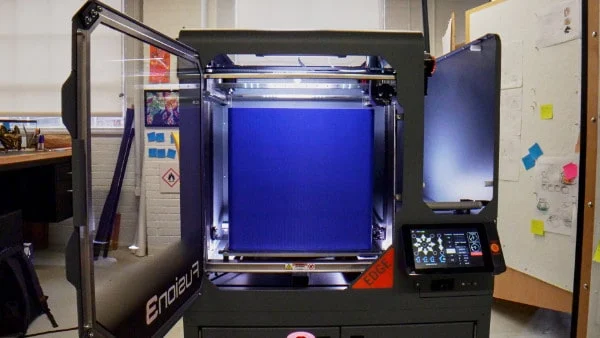THE BEST LIBRARY 3D PRINTERS
Most librarians and library technicians would not have expected 5 years ago that they would be running a 3D printing service bureau and a 3D printer library. However, 3D printing has become a key resource and service for patrons of public and university libraries. Just as you have to rely on laser printers and copiers, your 3D printer has to be able to deliver printed parts for students & patrons on schedule and within budget. Previously, your choice for 3D printing hardware was limited to either:
- Expensive industrial 3D printers which few organizations could afford
- Inexpensive consumer printers which lacked the speed, printable area of commercial 3D printers and are prone to breaking down with little assistance to get back up and running.
You now have another choice for your 3D printer library.

Stamps School of Art & Design, University of Michigan

Interested in learning how EDGE can be your next library 3D printer?
Complete More Patron Tasks With One 3D Printer
EDGE uses Fusion3’s patented ‘F-Series’ motion control system which enables printing of high-quality objects at superfast speeds (up to 250mm/s).
The large print bed and F3Slic3r software allow you combine multiple projects into one print.
Students & library patrons will spend less time waiting and more time designing, testing, and using their finished 3D printed parts.
Your library will become known for its capabilities for easy to use 3D printing.


More Uptime, Less Maintenance
Fusion3’s library 3D printers are much more durable and reliable than the consumer printers in its price range.
Every Fusion3 EDGE 3D printer undergoes extensive quality assurance ensuring the best performance right out of the box (no assembly required).
Your Fusion3 3D printer comes with an industry-leading 2-year warranty (compared to other manufacturers that provide 6-month to 1-year warranties).
Reliable Customer Service
If you ever have an issue, Fusion3 provides FREE technical support for the life of the printer and our factory support representatives are available from 8am to 8pm, Monday through Friday (Eastern) to help diagnose and resolve your issue.


Safe For Use In Libraries & Public Spaces
Fully enclosed and available with optional air filtration, the Fusion3 EDGE 3D printer is safe for use in public spaces and as a library 3D printer.
The enclosure protects again accidental contact with hot surfaces and is equipped with a door interlock, which will pause the printer if the door is opened during operation.
Combined with the air filter, smells and harmful emissions are contained ensuring comfort and safety for users of your library 3D printer.
“For a service that we are making available to all of our students and campus community, uptime is really important, and we knew Fusion3’s support and service was crucial to that.”
Adam Rodgers
Emerging Technology Services Librarian
NC State University
“We purchased the Fusion3 3D printers based upon the recommendation from other academic libraries and because their specifications met our needs. We liked the build quality of their printers and have been very pleased with the level of support provided.”
Sara Gonzalez
Physical Sciences, Mathematics, and Visualization Librarian
University of Florida
“Based on the speed, build volume and print quality, one Fusion3 3D printer could easily do the job of three or four standard desktop printers.”
Scott Grunewald
3DPrint.com

Fusion3 EDGE in the News
Read about how Fusion3 is helping Central Louisana Technical Community College support out healthcare workers.
FREQUENTLY ASKED QUESTIONS:
Library 3D Printers
Why should libraries use 3D printers?
How do I get started using a 3D printer in a library?

